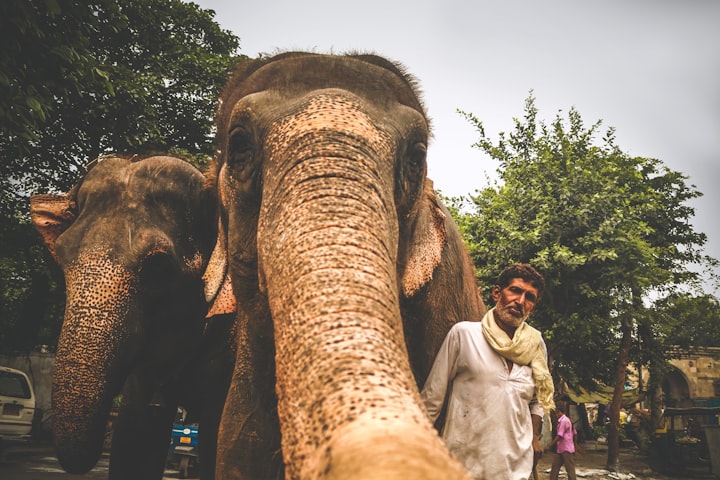Human and Elephant
similarities of human and elephant

The elephant is a remarkable creature that has long captured the fascination of humans around the world. Known for their size, strength, and intelligence, elephants are a symbol of wisdom and power in many cultures. These majestic animals have a complex social structure and strong family bonds, much like humans.
One of the most obvious similarities between elephants and humans is their social nature. Elephants are highly social animals that live in tight-knit family groups called herds. These herds are typically led by a matriarch, the oldest and most experienced female in the group. The matriarch plays a crucial role in guiding the herd, making decisions about where to find food and water, and protecting her family from predators. In many ways, the matriarch is like a human mother, looking out for the needs and safety of her family.
Elephants are also known for their strong emotional bonds with one another. They are capable of forming deep friendships and caring relationships within their herd. Elephants have been observed comforting and consoling one another in times of distress, much like humans do with their loved ones. They are also known to grieve the loss of a member of their herd, showing signs of mourning and sadness. This emotional depth and capacity for empathy are traits that humans share with elephants, further highlighting the connection between the two species.
Furthermore, elephants exhibit a remarkable level of intelligence that has been studied and documented by scientists. They are known to possess self-awareness, problem-solving abilities, and memory that rivals that of humans. Elephants have been observed using tools, showing creativity in their problem-solving techniques, and demonstrating an impressive level of adaptability. These qualities highlight the cognitive abilities of elephants and their capacity for learning and understanding, much like humans.
In addition to their social and emotional similarities with humans, elephants also face many of the same challenges and threats. Like humans, elephants are vulnerable to habitat loss, poaching, and human-wildlife conflict. As their natural habitats are increasingly encroached upon by human development, elephants are forced to compete for resources and navigate dangerous encounters with humans. Poaching for ivory remains a serious threat to elephant populations, leading to a decline in their numbers and putting them at risk of extinction. These shared challenges underscore the interdependence between humans and elephants and highlight the need for conservation efforts to protect these magnificent creatures.
Despite the many similarities between humans and elephants, there are also differences that make each species unique. Elephants have a keen sense of smell and hearing, as well as a remarkable ability to communicate through a variety of vocalizations, body signals, and infrasound. Their physical strength and endurance surpass that of humans, with the ability to carry heavy loads and cover great distances on foot. Elephants also have a long lifespan, with some individuals living up to 70 years in the wild.
In conclusion, the elephant is a fascinating and extraordinary creature that shares many similarities with humans. From their social nature and emotional depth to their intelligence and capacity for empathy, elephants exhibit qualities that resonate with us on a deep level. By recognizing and honoring these similarities, we can better appreciate the interconnectedness of all living beings and work together to protect and preserve the incredible diversity of life on our planet.(elephant and what relates him with human)
types of elephants
There are three main types of elephants in the world: the African bush elephant, the African forest elephant, and the Asian elephant.
The African bush elephant is the largest of the three types and is found in sub-Saharan Africa. They are known for their large ears, curved tusks, and wrinkled skin. These elephants primarily inhabit savannas, grasslands, and forests in countries such as Kenya, Tanzania, Botswana, and South Africa.
The African forest elephant is slightly smaller than its bush counterpart and is found in the forests of central and western Africa. These elephants have straighter tusks and smaller ears compared to the bush elephant. They are known to inhabit dense rainforests in countries like Gabon, Cameroon, and the Democratic Republic of the Congo.
The Asian elephant is found in countries such as India, Sri Lanka, Thailand, and Indonesia. They are smaller in size compared to African elephants and have smaller ears and different shaped tusks. Asian elephants inhabit a variety of habitats including forests, grasslands, and wetlands.
All three types of elephants are currently facing threats such as habitat loss, poaching for ivory, and human-elephant conflict. Conservation efforts are being made to protect these majestic creatures and their habitats to ensure their survival for future generations. It is important for us to raise awareness about the plight of elephants and take action to protect them from extinction.
About the Creator
naol abraham
now I am living here as a guest and um gonna leave this world one day!






Comments
There are no comments for this story
Be the first to respond and start the conversation.